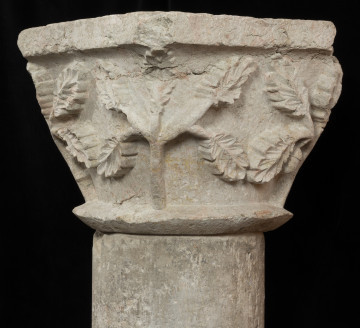
Capitol depicting meal of monks
1330 — 1340
National Museum in Szczecin
Part of the collection: Romanesque and early gothic stone capitals
The block and bell-shaped capital, typical for the Romanesque art, is decorated with bas-relief figural presentations, stylistically referring the item to the Gothic art. Together with another capital presenting four apostles, it was found in the ruins of the Szadzko Castle. It is assumed that capitals found their way there in a secondary mode: they were brought at the beginning of the 18th century as construction material for the rebuilding of the castle. On account of the theme of the presentations and the form and style referencing the group of Kołbacz capitals, their primary origin is related to the Cistercian monastery in Kołbacz. The genre scene shows the monks during preparation of food and the meal. The narrative comprises several ensuing episodes: there is a monk who, together with a smaller helper, are busy around a cauldron hanging above a fire, there is a monk carrying a dish with food from the kitchen to the refectory and further, the main scene showing the meal being eaten. Two monks are sitting at the table; next to them, there is another monk, partially preserved; he is standing and, in line with the rules of the order, performs of the role of the lector reading texts during the meal. The humoristic social element requires attention. Next to the table, a dog is trying to grab its portion of food. The capital, on account of its theme, could have decorated a column supporting the vault in the monastic premises of the refectory, where monks ate meals together.
Kinga Krasnodębska
Author / creator
Dimensions
cały obiekt: height: 44 cm, width: 52 cm
Object type
capital (architecture)
Creation time / dating
Creation / finding place
Identification number
Location / status

1330 — 1340
National Museum in Szczecin

1330 — 1340
National Museum in Szczecin

1330 — 1340
National Museum in Szczecin
DISCOVER this TOPIC
National Museum in Szczecin
DISCOVER this PATH
Educational path